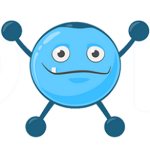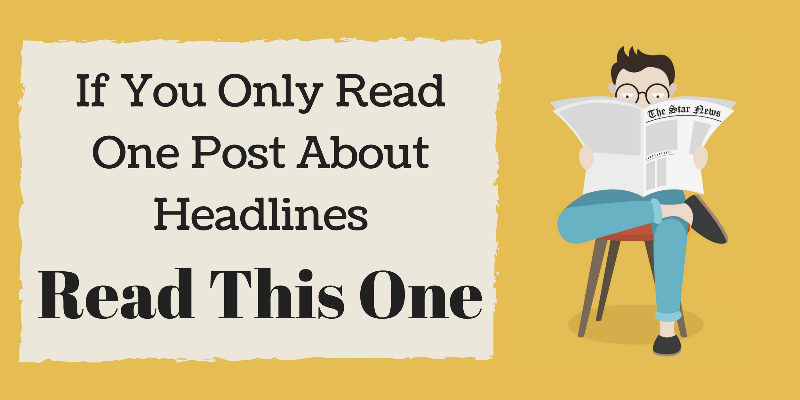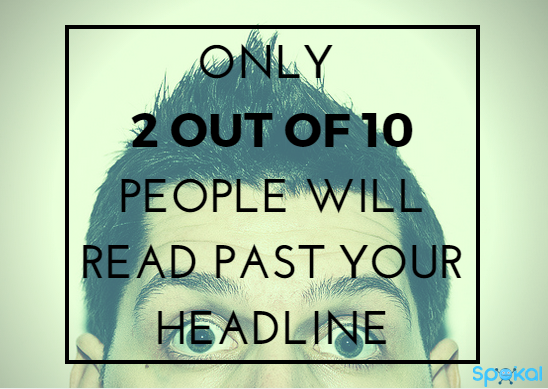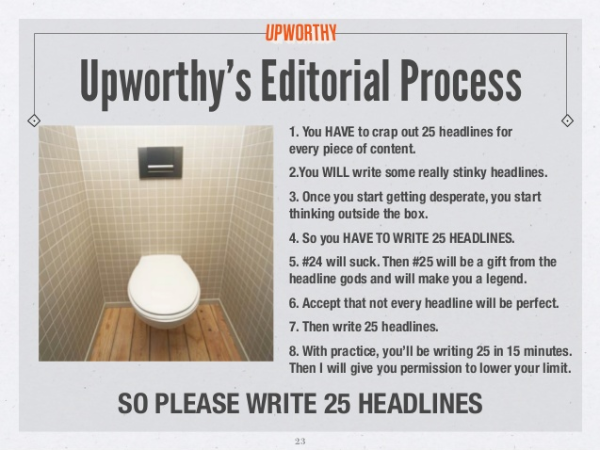Your headline is the first, and often the only, impression you make on a prospective reader. Without a compelling headline to entice your prospective readers into reading the rest of the content, your accompanying text is pointless – no matter how good it is.
Instead, your content will simply go unloved, unrecognized, undervalued and neglected until one day it will simply float off into a dark abyss where all content without captivating headlines go to die.
Dramatic, I know.
But it’s true.
On average, only 2 out of 10 people will read beyond your headline. That means that your headline literally has the power to make or break your content. The better than average your headline is, the better your chances are of having a larger audience read your content.
Simple, huh?
The pros know exactly how important creating headlines are, so they often follow the 50/50 rule which is when you spend just as much time on your headline (and the first few words/lines of your copy) as you do on creating your entire piece of content.
Given that most content takes hours, if not weeks to produce, you might be thinking that that’s a lot of time to spend on just a few words. Time that could be better spent on polishing up the rest of your content, maybe?
But think again.
As advertising legend David Ogilvy so succinctly puts it: “When you have written your headline, you have spent 80 cents out of your dollar.” And where else should you spend your time, but on the one area that requires such a huge investment of money?
Doesn’t seem so ridiculous now, does it?
Start With Your Headline
Before you get into the nitty gritty of writing your content, you’ll have done some brainstorming exercises that have solidified in your mind exactly what you want to write about. And while it’s tempting to get all this juicy information down on paper quickly, reign it in for a moment.
Start with your headline.
Why??
- Because it will inform the rest of your content.
- Because it will help to solidify exactly what you want to say.
- Because it ensures that you stay on topic.
- Because you can then be sure that you answer the questions that you set out to.
In summary: writing your headline first keeps you (and your brain) in check. It stops those over eager wandering fingers from running off topic, and away from your original point.
Take a Leaf Out of Upworthy’s Book and Write 25 Headlines
In an infamous anecdote that’s shared amongst marketers and writers everywhere, Ogilvy rewrote the famous headline from this automobile advertisement 104 times:
“At 60 miles an hour, the only thing you hear in the new Rolls Royce is the ticking of the dashboard clock …”
Why?
Because investing your time into creating irresistible headlines is the most critical step to getting your content actually read.
Upworthy shared their process for creating headlines in a Slideshow titled How to Make that One Thing Go Viral (just kidding). Their process, they claimed, relied heavily on one secret ingredient: Writing 25 headlines. According to Upworthy, writing 25 headlines ensured that you push your brain to think “outside the box.”
Trust me, it works.
And if you don’t trust me (I won’t hold it against you), check out how Medium fared when they took the Upworthy headline challenge.
The Debate on the Importance of Keywords in Headlines
There are two trains of thought when it comes to keywords in headlines.
The first, from the SEO camp, argue that keywords are necessary so that your content can be found in SERPs. How can people find your content through a search query, if you haven’t included a keyword that they can find it by?
The second, from the “write for humans, not for bots” camp argues that ranking in SERPs isn’t any use if no one is actually reading, sharing and commenting on the content. What’s the point in creating keyword dense headlines if no one will read them? The trick is to keep them human and that will encourage people to share the content themselves.
My approach to keywords in headlines is a little from column A, and a little from column B.
And by that I mean: Keywords are important… but only as far as you can still keep it human.
In reality, this just means approaching keywords from a different point of view than a purely technical standpoint. It means looking at keywords (and keyword research) as a way to get into the minds of your intended audience.
By doing keyword research, you’re not just catering to Google and SEO tactics (although that is an added bonus!), but you’re discovering how your audience searches for terms, what questions they’re asking in relation to your industry, who they’re looking for answers from, when they most need these answers and where they find these answers. Through keyword research, you gain insights that help you to create headlines that both speak to your audience, while also allowing you to make it easy for them to find through search engines!
To summarize: Keywords are important, but so is being accessible and human!
It turns out you can have your cake and eat it too!
Mmm. Cake.
Formulas for Headlines
The SHINE Headline Formula
A post by Bnonn for KISSmetrics outlined a five-part formula that they use to generate effective headlines that can be summed up in the acronym SHINE.
S – SpecificityH – HelpfulnessI – ImmediacyN – NewsworthinessE – Entertainment value
Specificity refers to… well, being specific. That means no lofty subjective claims like “this is the cutest puppy in the world!!!!!” Instead, use specific figures (if you have data), outline exactly who the post is for, or what exactly the post promises to do.
Helpfulness is exactly why “how to” posts are so popular. Answer a question, or have a solution, to a problem that your audience may be facing.
Immediacy encourages your readers to read your content now, rather than later (because they won’t read it later).
Newsworthiness can be summed up just as “new” in my mind. Is it something that people haven’t read about before? There’s not much that’s left untouched nowadays, so how does your post differ from the ones that came before it? What will stop people from saying “meh, I know all about that already”?
Entertainment value brings a promise of something enjoyable to read. It’s not going to be tedious business-talk, or exasperating academic jargon.
The Ultimate Formula (Based on Clicks)
Another formula that was created by Lenka Istvanova of Koozai Marketing after analyzing the best practices for headlines that get the most clicks. This formula is a little more basic, and goes like:
Numbers + Adjective + Target Keyword + Rationale + Promise
By following either formula, you can almost guarantee that your headline will capture your audience’s attention. And while you may not be able to apply the formulas to every headline you create, you can sure try!
Foolproof Headline Templates
You’re probably feeling a little overwhelmed with the amount of information I just loaded on you. But don’t worry, I’m not going to leave you without a decent start off point to get you on your way.
The following are 10 headline templates that have been tried and tested by marketers and writers for years, and have been proven to catch a potential reader’s attention.
- How to…
- Little Known Ways to…
- What Everyone Should Know About…
- The Secret of…
- The Ultimate Guide to…
- The Beginners Guide to…
- 10 ways to… (general listicles)
- Lessons I Learned From…
- How You Can Easily/Quickly…
- Never Do This…
More extensive headline template resources:
- 10 Sure-Fire Headline Formulas That Work
- 7 More Sure-Fire Headline Templates That Work
- 30+ Ultimate Headline Formulas for Tweets, Posts, Articles, and Emails
- 43 Powerfully Simple Fill-in-the-Blank Blog Post Headline Templates
- 9 Classic Headline Templates
A/B Testing Your Headlines
Testing your headlines is the only way to be certain that you’re working towards better titles every time you write. Without testing, you’re reaching out in the dark, hoping that you’ve gaged your audience correctly, but never knowing for sure if there’s a better way to do it.
Testing your headlines is simple.
You take 2 optional headlines that you like. You send them out into the world. You gage how successful each of them performed, and you focus on creating headlines that have similar traits as the more successful one does. You keep doing this for as long as you have to until you think you’ve perfected the skill of mind reading! (This is my passive aggressive way of telling you that you’ll probably be testing your ’till the day you hang up your keyboard!)
Spokal users: Follow this link to read more about how to set up A/B title testing in Spokal.
And you’ll often be surprised by which headlines perform better.
Jeff Weberg of LeadPages discovered this for himself when he tested two different headlines for his Ebook landing page.
There are, of course, several platforms that are available that allow you to A/B split test your headlines. Optimizely and Visual Website Optimizer are the two favorite tools for running A/B split tests on your headlines.
Other Amazing Tools To Help You Create Awesome Headlines
Portent Title Maker
This is a great little tool that helps to get you thinking outside of the box. You often get headlines that are a little more “out there” but it’s easy to reign them in and come up with something awesome!
Spokal users: You can find the Portent Title Maker right in the Editor, under the SEO tab at the right hand side of your screen.
Moz’s Title Tag Preview Tool
A lot of SEO minded people will tell you that headlines should be longer than about 55 characters. That’s because after 55 characters (or so, it all depends on the size of the characters you use) your title will be cut off like so:
While there isn’t much evidence that this makes any real impact on whether people click on your page or not, it doesn’t do any harm to try and stay within the limits – But don’t sacrifice quality to do so. Remember: the entire title is still crawled by Google, so even if you’re keywords are cut off, they’ll still be ranked.
Conclusion
Headlines are the single most influential part of your content. Without a them, your content might as well cease to exist.
With these formulas, templates and tools, you’ll be able to start creating headlines that captivate and intrigue your audience – ensuring that they keep on reading.
But there is one more thing that you need.
Just one more thing.
Practice.
Practice makes perfect. Test your headlines, see what works and what doesn’t, change them up, get creative and, by all means, have fun with it too!
Liked this?
 Get more info on content marketing straight to your inbox! We've awesome content we're dying to send you, like an A-Z dictionary of online marketing terms PDF and bunch of content creating templates!
Get more info on content marketing straight to your inbox! We've awesome content we're dying to send you, like an A-Z dictionary of online marketing terms PDF and bunch of content creating templates!




